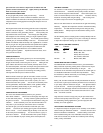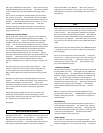Special offers from our partners!

Find Replacement BBQ Parts for 20,308 Models. Repair your BBQ today.

14
t
t
1. The smell of gas in conjunction with the burner flames appearing
Yellow.
2. When you light the grill, sound is significantly different than
normal.
3. The Grill does not reach temperature.
4. The Grill heats unevenly.
5. The burners make popping noises.
BEFORE CALLING FOR SERVICE/TROUBLESHOOTING
CHECKLIST
Grill won't light when the igniter button is depressed.
Replace Battery
Ensure electrode is attached to igniter module and also to the end of
the electrode behind the burners. DO NOT TURN THE CONTROL
VALVE "ON" AT THIS STAGE. Depress the igniter button and
watch the igniter tip. You should see a spark jump from the tip of the
igniter when the button is pressed. If there is no spark, clean the
igniter tip and free from debris. Readjust for proper gap.
If there is a spark, is there gas supplied to the unit and is the link
purged of air?
Can you match light the burner?
Check the orifice for blockage
Burner flame
is
yellow or orange, or is there the odor of gas.
Turn the burner off
Check the burner inlet for obstructions (spiders, etc).
Adjust the air shutter rings to allow more or less gas found at the end
of the burner venturi.
Is the grill in a dusty area?
Low heat - with the con rol
knob
set to he "HI" position.
Does the orifice or burner need cleaning?
Is the gas supply, or gas pressure low?
Is the grill being preheated for 3 minutes?
Is there L.P. gas in the tank?
CARE OF STAINLESS STEEL
Stainless Steel is widely used for catering and residential kitchen
equipment because of its strength, its ability to resist corrosion and its
ease of cleaning. In fact, stainless steel ranks alongside glass and new
china in terms of "ease of cleaning" and in percentage removal of
bacteria during washing up. As a result of these virtues, the metal is
often taken for granted and it is assumed that no problems will arise
during its usage. However, some care is required to ensure that the
stainless steel can live up to this reputation.
DAY-TO-DAY CARE
To maintain the original appearance of your PGS, a regular cleaning
routine should be carried out using the following guidelines:
1. After use, wipe the Grill with a soft, damp, soapy cloth and rinse
with clean water, preferably warm/ hot water. This should remove
most substances encountered during the grilling process.
2. For more tenacious deposits, including oil, grease and water-borne
deposits, PGS has a wonderful spray cleaner and also cleaning “wipes”.
Please see your local dealer.
3. Harsh abrasives and scouring materials should not be used for
cleaning stainless steel as they will leave scratch marks in the surface
and damage the appearance of the Grill. Likewise do not use wire
brushes, scrapers or contaminated scouring pads.
4. Your PGS Grill has a directional polished grain, any cleaning with
abrasives should be carried out along this grain and not across it
5. If required, dry the Grill after use with a soft dry cloth or towel.
If the preceding guidelines are adhered to, your PGS Stainless Steel
Grill should offer excellent life and should live up to its reputation of
being "stainless". Neglect of this practice, however, can lead to
deterioration of the surface and, in some extreme cases, corrosion of
the steel itself. The two most common types of corrosion that may be
encountered, particularly on stainless steel, are rust marks and pitting
of the surface.
RUST MARKS
When this type of staining occurs it is unlikely that rusting of the
stainless steel itself causes the marks. Similar marks can be found
with both porcelain and plastic sinks. The rust marks are more likely to
be the result of small particles of "ordinary "steel which have become
attached to the surface; these have subsequently rusted in the damp
environment. The most common source of such particles is from
"wire-wool" scouring pads, but contamination may also occur from
carbon steel utensils and cast iron water supply pipes.
These brown marks are only superficial stains, which will not harm the
Grill; they should be removable using a soft damp cloth and a quality
stainless cleaner. Occasionally, it may be necessary to resort to a
proprietary stainless steel cleanser, to return the surface
of the Grill to its original condition. To avoid re-occurrence of any
"rust-staining" it is essential that the source of the contamination be
eliminated.
PITTING
Another form of corrosion, which occasionally occurs in stainless steel,
is pitting of the surface. The reason for this corrosive attack can
usually be attributed to certain household products. for example:
Bleaches:
Most common domestic bleaches & sterilizing solutions contain
chlorine in the form of sodium hypochlorite. If used in concentrated
form, bleaches can attack the stainless steel, causing pitting of the
surface. They should always be used to the strengths prescribed by
the manufacturer and should be thoroughly rinsed
off
with clean water
immediately after use.
Foodstuffs;
In general stainless steel is fully resistant to all foodstuffs in common
use. Only in isolated cases, such as when concentrated salt and
vinegar mixtures are allowed to remain in contact with the steel for
along period, can any surface marking result.
COOKING GRIDS
Routine cleaning of the grill grids is best accomplished by scrubbing
the grids with a brass or stainless steel brush immediately before and
after cooking, while the grill is hot. Wear a barbeque mitt to protect
your hand from the heat while cleaning. When needed, remove the
grids from the grill and scrub with a soap solution or oven cleaner.
Rinse thoroughly, and allow the grids to dry completely before
reinstalling onto grill.
MASONRY ENCLOSED GRILL
PGS grills are easily installed in Masonry enclosures. No additional
supports “frames” are necessary. We have included a natural gas
regulator set at 5 1/2” w.c. which must be installed for proper grill
performance. Please have masonry contractor examine grill before
building enclosure to ensure proper clearance for the natural gas
regulator and gas connection from building material. A “carve out”
of the masonry material may be necessary to accommodate regulator
combination shown on page 10.
ENCLOSURE MUST BE CONSTRUCTED ON A


















